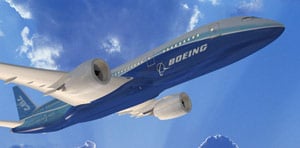This article is more than 1 year old
787 unsafe, claims former Boeing engineer
Dreamliner crash and burn?
A former Boeing engineer claims the 787 Dreamliner is unsafe, and that in the event of a crash its innovative composite material fuselage would "shatter too easily and burn with toxic fumes", the Seattle Times reports.
 Vince Weldon was sacked in July 2006 from his post as senior aerospace engineer at Boeing's Phantom Works research unit for "disputed reasons". He argues that "without years of further research, Boeing shouldn't build the Dreamliner and that the Federal Aviation Administration (FAA) shouldn't certify the jet to fly".
Vince Weldon was sacked in July 2006 from his post as senior aerospace engineer at Boeing's Phantom Works research unit for "disputed reasons". He argues that "without years of further research, Boeing shouldn't build the Dreamliner and that the Federal Aviation Administration (FAA) shouldn't certify the jet to fly".
Weldon's allegations are detailed in a letter to the FAA, which claims:
- The brittleness of the plastic material from which the 787 fuselage is built would create a more severe impact shock to passengers than an aluminum plane, which absorbs impact in a crash by crumpling. A crash also could shatter the plastic fuselage, creating a hole that would allow smoke and toxic fumes to fill the passenger cabin.
- After such a crash landing, the composite plastic material burning in a jet-fuel fire would create "highly toxic smoke and tiny inhalable carbon slivers" that "would likely seriously incapacitate or kill passengers".
- The recently conducted crashworthiness tests — in which Boeing dropped partial fuselage sections from a height of about 15 feet at a test site in Mesa, Ariz. — are inadequate and do not match the stringency of comparable tests conducted on a 737 fuselage section in 2000.
- The conductive metal mesh embedded in the 787's fuselage surface to conduct away lightning is too light and vulnerable to hail damage, and is little better than a "Band-Aid."
In a "whistle-blower complaint" filed with the U.S. Occupational Safety and Health Administration (OSHA), Weldon claimed that his firing was "retaliation for raising concerns throughout the last two years of his employment about the crashworthiness of the 787".
Boeing, however, told the OSHA he was "dismissed for threatening a supervisor, specifically for stating he wanted to hang the African-American executive 'on a meat hook' and that he 'wouldn't mind' seeing a noose around the executive's neck", the Seattle Times reports.
OSHA dismissed Weldon's claim, denying him whistle-blower status "largely on the grounds that Boeing's 787 design does not violate any FAA regulations or standards".
FAA spokesman Mike Fergus confirmed earlier this week the 787 will "not be certified unless it meets all the FAA's criteria, including a specific requirement that Boeing prove passengers will have at least as good a chance of surviving a crash landing as they would in current metal airliners".
A Boeing spokeswoman assured the Seattle Times: "We have to demonstrate [to the FAA] comparable crashworthiness to today's airplanes. We are doing that."
She elaborated that recent crash tests were "successful but are only the beginning of a process that relies on computer modeling to cover every possible crash scenario". The tests also demonstrated that "shards of composite material released in a crash are not a shape that is easily inhaled", and that "the smoke produced by composites in a jet-fuel fire is no more toxic than the smoke from the crash of an aluminum plane".
Finally, she confirmed the Dreamliner's lightning protection "will meet FAA requirements".
Weldon's serious allegations come as Boeing is struggling to keep the Dreamliner to its original launch schedule. It planned the aircraft's maiden flight for August, now put back to mid-November to mid-December due to a "critical shortage of aerospace fasteners to hold the airplane together", as the Wall Street Journal explains.
Company execs have, nonetheless, declared Boeing will deliver the first example in May 2008, despite industry pundits and "a number of the plane's suppliers" describing this feat as "the aerospace equivalent of hitting a hole in one on a golf course".
Indeed, if the 787 took to the air in mid-November, Boeing would have just six months to complete the flight test and certification program - compared to 11 months for the 777.
Boeing has secured 684 Dreamliner orders from 47 customers. All-Nippon Airways will be the first to get its hands on the controls, and is reportedly pretty relaxed about any potential delivery delay since it will deploy the airliner to replace its 767 fleet, and can continue to operate the latter were it necessary. ®
Further info
For the planespotters among you, here are some vital stats from Boeing:
The 787-8 Dreamliner will carry 210 - 250 passengers on routes of 7,650 to 8,200 nautical miles (14,200 to 15,200 kilometers), while the 787-9 Dreamliner will carry 250 - 290 passengers on routes of 8,000 to 8,500 nautical miles (14,800 to 15,750 kilometers). A third 787 family member, the 787-3 Dreamliner, will accommodate 290 - 330 passengers and be optimized for routes of 2,500 to 3,050 nautical miles (4,600 to 5,650 kilometers).
In addition to bringing big-jet ranges to mid-size airplanes, the 787 will provide airlines with unmatched fuel efficiency, resulting in exceptional environmental performance. The airplane will use 20 percent less fuel for comparable missions than today's similarly sized airplane. It will also travel at speeds similar to today's fastest wide bodies, Mach 0.85. Airlines will enjoy more cargo revenue capacity.
